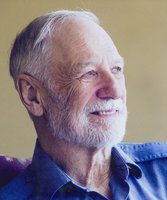A. David May passed away in December, 2024, at the age of 91. David was an atomic spectroscopist and laser physicist who joined the faculty in the 1960’s and remained scientifically active after his retirement in the mid-1990’s. According to the obituary prepared by his family,
David attended the University of Toronto, completing the honours physics program and continued his graduate studies under Profs. Welsh and Stryland, receiving his PhD degree in 1957. His PhD thesis entitled “The Raman Spectra of Gases at High Pressure,” looked at the spectrographic ‘fingerprints’ of light scattering from vibrational modes of simple molecular gases under higher pressures than had been previously studied.
Dr. May joined the University of Toronto faculty as a professor in the early 1960s taking on a vigorous experimental research program in spectroscopy in conjunction with teaching. His research on spectral properties of atomic and molecular gases required highly specialized equipment that often needed to be built from scratch. The University of Toronto Scientific Instruments Collection holds at least two Helium-Neon lasers that David built in collaboration with the Department’s glassblowing technician, Jack Legge.
David taught courses for both physics and engineering students. His teaching style was open and laid-back. He was happy to take questions at any time in order to make sure students were keeping up with the lecture. His courses included quantum mechanics and he was quite effective at explaining what can be an obscure subject.
David ventured briefly into politics, running for city council in the early 1970s. He lost the election and retired from politics, but some of the lawn signs made it to the art program at the University of Toronto Schools to be used as craft material. A couple of years later, some students showed up with a poster in one of his undergraduate lectures for some good-natured joshing of their professor. An observant student noticed that David was wearing the same tie in the poster photo as he had on in class that day. As soon as this was pointed out, he pulled the tie off with a flourish and threw it in the wastebasket.
He enjoyed a lifelong career at the University of Toronto and continued with research after retiring from teaching. His final paper, “The impact theory of spectral line shapes: a paradigm shift” by A.D. May, W.-K. Liu, et al., was published in the 2013 issue of the Canadian Journal of Physics (Vol 91[11]).
In 1981, David was named as a Fellow of the Optical Society of America, the professional society of researchers in the physics of light (now known as Optica.)”
He is remembered fondly by several colleagues here. His former Ph.D. student, Prof. Emeritus Stephen Morris, said
he very graciously allowed me to ‘do my own thing’ for my unorthodox PhD project. … He was always an enthusiastic researcher with a can do attitude.
Prof. Kim Strong provided more background on his scientific contributions, pointing out that he co-authored an article on spectroscopy research in McLennan Physics (https://opg.optica.org/ao/abstract.cfm?URI=ao-6-10-1597) and noting his collected papers at https://search.worldcat.org/title/225483228.
Prof. Emeritus Jim Drummond recalled him as
… a great colleague to work with, and we got on very well. Two things that I remember: Our first collaboration was examining the 4.7um of carbon monoxide to see if we could learn anything, and a decade later and many papers later, we were still at it. The other thing was that we had a difference in grammar style on commas. So, in every iteration of a paper draft, I put them in, and he took them out.
Prof. Emeritus Henry van Driel recalled more of his background and contributions to the department:
He took his PhD with Harry Welsh in 1959, having worked on the Raman effect in molecular gases. Following two years as a pdf in France he returned to the Department as an Assistant professor. He was mainly interested in atomic spectroscopy (especially lineshapes of atomic transitions) during his career but in the early 1960’s, shortly after the invention of the laser, he also researched and built He-Ne and CO2 lasers. One of his 2m long He-Ne lasers made it into the Advanced Undergrad lab and was still there and functioning the last time I looked about 5 years ago. Remarkable….although it says as much about how modern the undergrad lab was until recently.
I always liked Dave as a colleague. He was always generous with his time in helping others…
We extend our sincere condolences to his family on this loss and will share our fond remembrances of David with them.
By Paul Kushner

